AUDI S3 2011 Owners Manual
Manufacturer: AUDI, Model Year: 2011, Model line: S3, Model: AUDI S3 2011Pages: 320, PDF Size: 75.79 MB
Page 131 of 320

______________________________________________ D_ ri _v _ i_n _,,g ,c.._ S_a_ f_ e_ l..:: y __ _
- If there are passengers in the rear seat , slide the head
restra ints u pward at least to the next notch on the occu
p ied seats .
Adjusting head restraints ~ page 77.
& WARNING
Driving without head restraints or with head restraint s that are
not properly adjusted increases the risk of serious o r fatal neck
injury dramatic ally . To help reduce the ri sk of injury:
• Always drive with the head rest raints in place and prope rly
adju sted.
• Every person in the vehicle must have a prope rly adjusted head
restraint .
• Always make sure each per son in the vehicle properly adjusts
their head restraint. Adjust the head restraints so the upp er edge
is as even a s possible with the top of you r head . If that is not
possible, try to adjust the head re straint so that it is as close to
this position as possible.
• Never attempt to adjust head restraint while driving. If you
have driven off and mu st adjust the driver headrest for any reason,
first stop the vehicle safely before attempting to adjust th e head
restraint.
• Children must alway s be properly restrained in a child re straint
that is appropriate for their age and size~
page 167. •
Examples of improper seating positions
The occupant r estraint system con only reduce th e risk o f
injury if vehicle occupants ore properly seated.
Improper seat ing positio ns can cause se rious injury o r death.
Safety belts can only work w hen t hey are properly posi tione d
on t he body . Improper seating positio ns re duce the effective-
Controls and equip
ment Safety first Vehicle operation
ness of s
afe ty belts an d wi ll even increase the risk of injury
and deat h by moving the safety b elt to c rit ica l areas of t he
bo dy. Imp roper seating pos itions also i ncrease the risk of
serious inju ry and dea th w hen an ai rbag deploys a nd strikes
an occ upant who is not in t he proper seati ng pos ition . A
d river is respons ib le for t he safety o f all vehicle occupants
and especia lly for ch ildren. Therefore:
- Nev er a llow anyone to assume an incorrect seating pos i-
t io n whe n the vehic le is bei ng used=> &.
The follow ing b ulletins list only some samp le posi tions that will
increase the risk of se rious injury and death . O ur hope is that these
examples will ma ke you more aware o f seating positions t hat are
dange ro us.
Therefore , whenever the vehicle is moving:
• never stand up in the vehicle
• never stand on the seat s
• never knee l on t he seats
• never ride with the seatback reclined
• never lie down on the rear se at
• never lean up against the instrument panel
• never sit o n the edge of the seat
• never sit s ideways
• never lean out the w indow
• never p ut yo ur fee t out the window
• never p ut yo ur feet on the instrument panel
• never rest your feet on the seat c ush io n or back of the seat
• never ride in the footwe ll
• never ride in the cargo area
Vehicle care Do-it-yourself service Technical data
Page 132 of 320
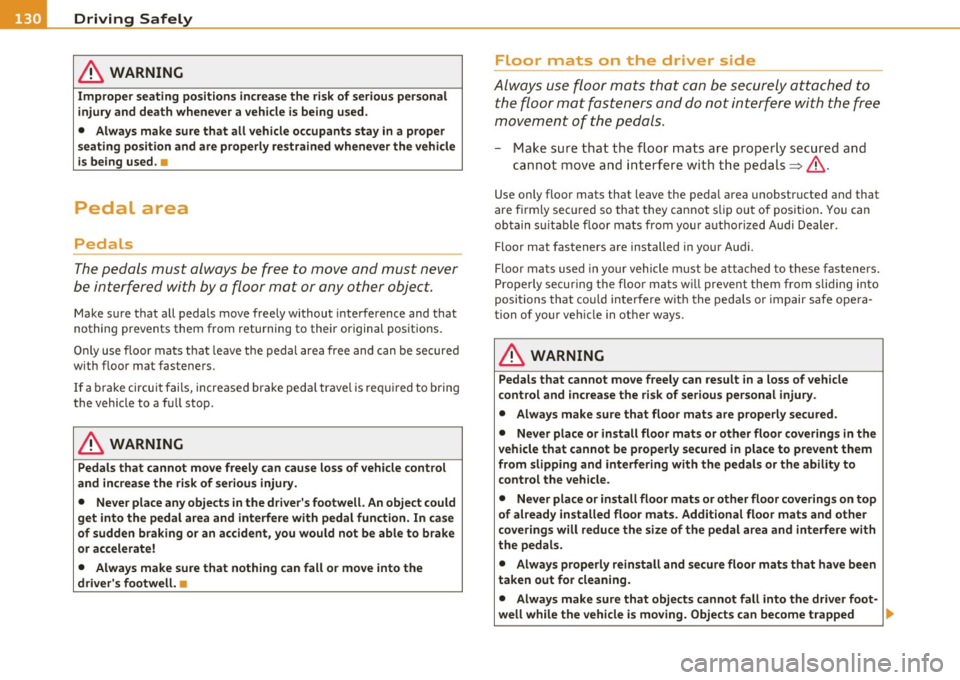
........ _D_ r_iv _i_ n .... g=-- S_ a_f _e _Ly :,.._ ______________________________________________ _
in. WARNING
Improper seating positions increase th e risk of serious personal
injury and de ath whenever a vehicle is being used.
• Always make sure th at all veh icle occupants stay
in a proper
seating position and are properly re strained when ever the vehicle
is being used. •
Pedal area
Pedals
The pedals must al ways be free t o move and mus t neve r
be in terfered wit h by a floor mat or any other object.
Make s ure that all pedals move free ly without interference and t hat
nothing prevents them from returning to their original pos itions.
On ly use floor mats that le ave t he pedal area free and can be secured
with floor mat fasteners.
If a brake circu it fails, increase d bra ke peda l trave l is re quir ed to b ring
the vehicle to a f ull stop .
in. WARNING
Pedals that cannot mo ve freely can cause loss of vehicle control
and increase the risk of serious injury.
• Never place any objects
in the driver 's footwell. An object could
get into the pedal area and interfere with pedal fun ction. In case
of sudden braking or an accident , you would not be able to b rake
or accelerate!
• Always make sure that nothing can fall or move into the
driver' s footwell. •
Floor mats on the driver side
Always use floor mats th at can be se curely a ttached to
the floo r mat fasteners and d o not inte rfe re with the free
movem ent of th e pedals.
- Make su re that t he floor mats are proper ly secured a nd
cannot move and i nte rfere with t he ped als=> &.
Use on ly floor ma ts that leave the peda l area unobstructed and that
are firm ly sec ured so that they cannot s lip out o f position. Yo u can
ob tain su itab le floor mats from you r autho rized Audi Dealer .
Floor mat fasteners are installed in your A ud i.
F loor m ats used in your vehicle m ust be att ached to t hese f astene rs.
Properly securing t he floor mats w ill prevent them from s liding into
posi tions that cou ld i nterfere w it h t he ped als o r impair safe ope ra
t ion of your veh icle in other ways .
in. WARNING
Pedals that cannot move freely can result in a loss of vehicle
c ontrol and in crease the risk of seriou s per sonal injury .
• Always make sure that floor mats are properly secured .
• Never place or install floor mats or other floor coverings in the
vehicle that cannot be properly secured in place to prevent them
from slipping and interfering with the pedals or the ability to
control the vehicle.
• Never place or install floor mats or other floor coverings on top
of al ready installed floor mats . Additional floor mats and other
coverings will reduce the size of the pedal area and interfere with
the pedals.
• Always properly rein stall and secure floor mats that have been
taken out for cleaning.
• Always make sure that objects cannot fall into the driver foot-
well while the vehicle is moving. Objects can become trapped
~
Page 133 of 320

& WARNING (continued)
under the brake pedal and accelerator pedal causing a loss of
vehicle control. •
Stowing luggage
Loading the luggage compartment
All luggage and other objects must be properly stowed
and secured in the luggage compartment.
~ ... a'. ., m
Fig . 124 Safe load
positioning: heavy
cargo positioned as far
forward as possible.
Loose items in the luggage compartment can shift suddenly,
changing vehicle handling characteristics. Loose items can
also increase the risk of serious personal injury in a sudden
vehicle maneuver or in a collision.
- Distribute the load evenly in the luggage compartment.
- Always place and properly secure heavy items in the luggage compartment as far forward as possible
~ fig . 124.
- Secure luggage using the tie-downs provided~ page 82.
Safety first Vehicle OP-eration Driving
Safely
-
Make sure that the rear seatback is securely latched in
place.
& WARNING
Improperly stored luggage or other items can fly through the
vehicle causing serious personal injury in the event of hard braking or an accident. To help reduce the risk of serious personal injury:
• Always put objects, for example, luggage or other heavy items
in the luggage compartment.
• Always secure objects in the luggage compartment using the
tie-down eyelets and suitable straps.
& WARNING
Heavy loads will influence the way your vehicle handles. To help
reduce the risk of a loss of control leading to serious personal
injury:
• Always keep in mind when transporting heavy objects, that a
change in the center of gravity can also cause changes in vehicle
handling:
-Always distribute the load as evenly as possible.
- Place heavy objects as far forward in the luggage compart-
ment as possible.
• Never exceed the Gross Axle Weight Rating or the Gross Vehicle
Weight Rating specified on the safety compliance sticker on the
left door jamb. Exceeding permissible weight standards can cause
the vehicle to slide and handle differently.
• Please observe information on safe driving=>
page 124.
& WARNING
To help prevent poisonous exhaust gas from being drawn into the
vehicle, always keep the rear lid closed while driving . .,_
Vehicle care Do-it-yourselt service iTechnical data
Page 134 of 320
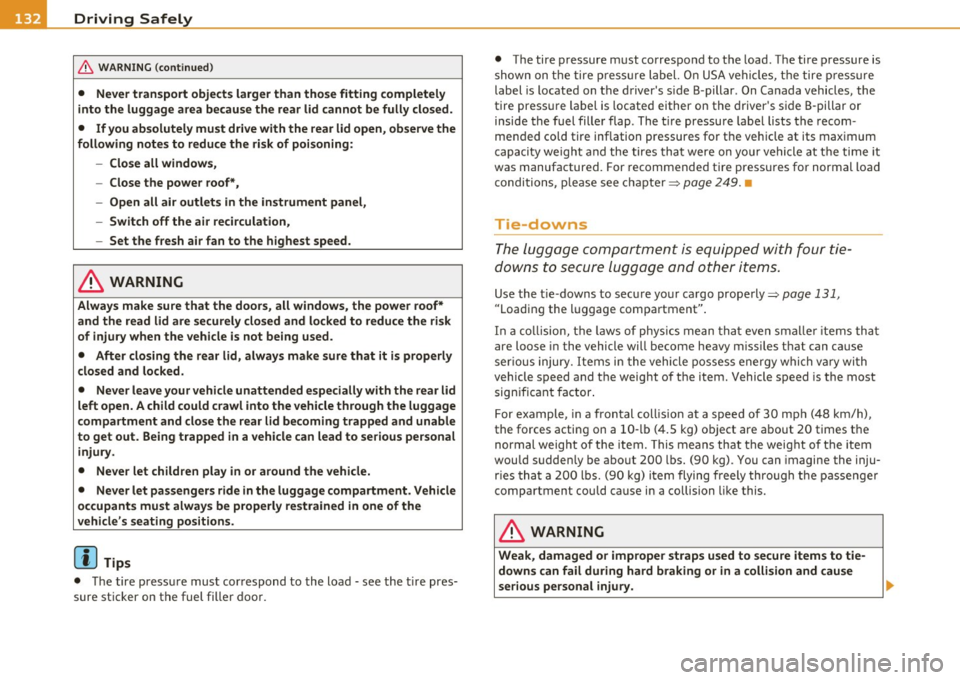
-L_!:D~ r!:_! i~v ~in ~ g~S~ a.!_fe ~ LyL __________________________________________ _
& WARNING (conti nu ed )
• Never tran sport object s larger than those fitting completely
into the luggage are a because the rear lid cannot be fully clos ed.
• If you absolutely must dri ve with the rear lid open , observe the
following note s to reduce the risk of po isoning:
- Clo se all windows,
- Close the power roof*,
- Open all air outlets in the instrument panel,
- Switch off the air recirculation ,
- Set the fresh air fan to the h ighest speed.
& WARNING
Always make sure that the doors , all windows, the power roof*
and the read lid are securely closed and lo cked to redu ce the ri sk
of inju ry when the vehicle is not being used.
• After closing the r ear lid, always make sure that it is properly
closed and locked.
• Never leave your vehicle unattended especially with the rear lid
left open. A child could crawl into the vehicle through the luggage
compartment and close the rear lid becoming trapped and unable
to get out. Being trapped in a vehicle can lead to serious personal
injury.
• Never let children play in or around the vehicle.
• Never let passengers ride in the luggage compartment . Vehicl e
occupants must alway s be properly restrained in one of the
vehicle 's seating positions.
00 Tips
• The tire pressu re mus t cor respond to the load - see the tire pres
sure st icker on th e fuel filler doo r. •
The tire pressure must correspo nd to the load . The tire p ressure is
shown on t he tire press ure label. O n USA ve hicl es, t he tire press ure
label is located on the d river's s ide B-pillar. On Canada vehicles, the
tire press ure label is located either on the driver 's side B -pillar or
inside the fuel fille r flap . The t ire pressure labe l lists the recom
mended co ld ti re inflation pressures for t he ve hicle at its maximum
c apacity weight and the tires that were on yo ur vehicle at the ti me it
was manufactured. For recommended tire pressures for normal load
c ondi tions, p le ase see cha pte r=>
page 249. •
Tie-downs
The lugg ag e co mportment is equipped with four tie
downs to secure lugga ge and other items.
Use the t ie-downs to sec ure your ca rgo prope rly=> page 131,
"Loading the luggage compartment" .
In a co lli sion, t he laws of phys ics mean tha t even sma ller i tems th at
are loose in the vehicle will become heavy m issi les t hat can cause
ser ious injury. Items in the vehicle pos sess energy whi ch v ary wi th
vehicle speed and t he weight of the item. Vehicle speed is the most
significant factor .
For exampl e, in a fron tal col lis io n at a speed of 30 mp h (4 8 k m/h),
the forces actin g on a 10 -lb (4.S kg) o bject are about 20 times t he
normal weight o f the item. This means that the weig ht of the item
wou ld suddenly be abo ut 200 lbs. (90 kg) . You can imagine the inju
r ies tha t a 200 lbs. (90 kg) i tem flying freely thro ugh t he p assenge r
compartment could cause in a collision like this.
& WARNING
Weak , damaged or improper straps used to secure items to t ie
downs can fail during hard braking or in a collision and cause
ser ious personal injury.
Page 135 of 320

& WARNING (continued)
• Always use suitable mounting straps and properly secure items
to the tie-downs in the luggage compartment to help prevent items from shifting or flying forward as dangerous missiles.
• When the rear seat backrest is folded down, always use suit
able mounting straps and properly secure items to the tie-downs
in the luggage compartment to help prevent items from flying
forward as dangerous missiles into the passenger compartment.
• Never attach a child safety seat tether strap to a tie-down. •
Reporting Safety Defects
Applicable to U.S.A.
If you believe that your vehicle has a defect
which could cause a crash or could cause injury
or death, you should immediately inform the National Highway Traffic Safety Administration
(NHTSA) in addition to notifying Audi of
America, Inc.
If NHTSA receives similar complaints, it may
open an investigation, and if it finds that a
safety defects exists in a group of vehicles, it
may order a recall and remedy campaign.
However, NHTSA cannot become involved in
individual problems between you, your dealer,
or Audi of America, Inc.
To contact NHTSA, you may call the Vehicle
Safety Hotline toll-free at:
Controls and equip ment Safety first Vehicle operation
Driving Safely
-
Tel.: 1-888-327-4236 (TTY: 1-800-424-9153)
or write to:
Administrator
NHTSA
1200 New Jersey Avenue, SE
Washington, D.C. 20590
You can also obtain other information about motor vehicle safety from:
http:/ /www.safercar.gov
Applicable to Canada
Canadian customers who wish to report a
safety-related defect to Transport Canada, Defect Investigations and Recalls, may tele
phone the toll free hotline :
Tel.: 1-800-333-0371 or
Tel.: 1-613-998-8616 if you are in the Ottawa
area
TTY for hearing impaired: 1-888-675-6863
email comments/questions to: roadsafetyweb
[email protected]
or contact Transport Canada by mail at:
Road Safety and Motor Vehicle Regulation
Directorate
Transport Canada
Vehicle care Do-it-yourself service Technical data
Page 136 of 320
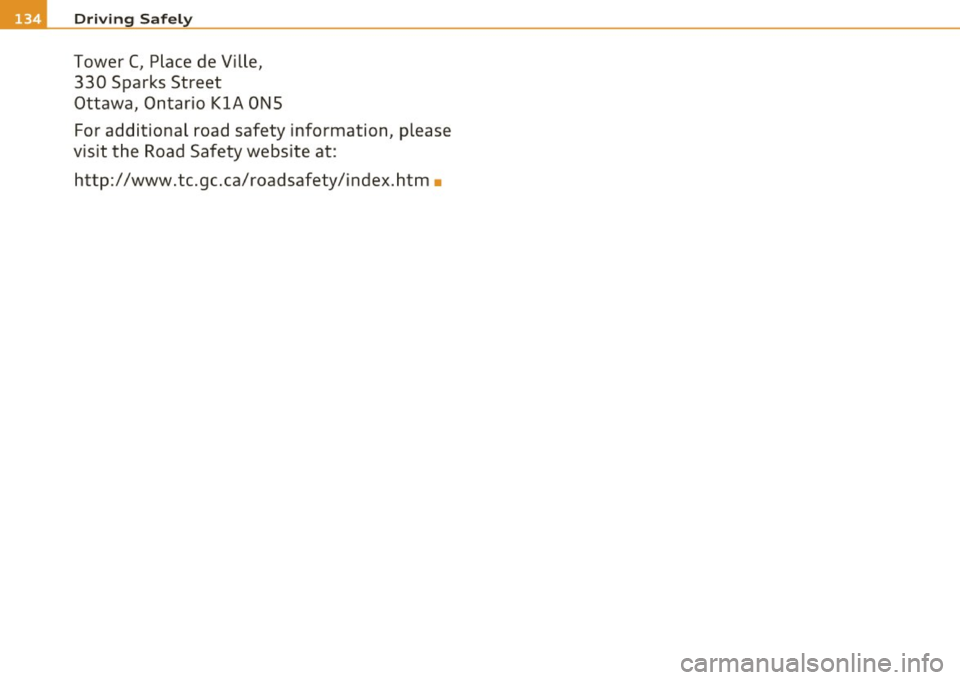
ffl Driv ing Sa fely
Tower C, Place de Ville,
330 Sparks Street
Ottawa, Ontario
KlA ONS
For additional road safety information, please
visit the Road Safety website at:
http:/ /www.tc.gc.ca/roadsafety/index.htm •
Page 137 of 320

Safety belts Ill
----------------
Safety belts
General notes
Always wear safety belts!
Wearing safety belts correctly saves lives!
This chapter explains why safety belts are necessary, how
they work and how to adjust and wear them correctly.
- Read all the information that follows and heed all of the
instructions and WARNINGS.
& WARNING
Not wearing safety belts or wearing them improperly increases
the risk of serious personal injury and death.
• Safety belts are the single most effective means available to
reduce the risk of serious injury and death in automobile acci
dents. For your protection and that of your passengers, always
correctly wear safety belts when the vehicle is moving.
• Pregnant women, injured, or physically impaired persons must
also use safety belts. Like all vehicle occupants, they are more
likely to be seriously injured if they do not wear safety belts. The
best way to protect a fetus is to protect the mother - throughout
the entire pregnancy. •
Number of seats
Your Audi has a total of five seating positions: two in the front and
three in the rear . Each seating position has a safety belt .
Controls and equip
ment Safety first Vehicle operation
& WARNING
Not wearing
safety belts or wearing them improperly increases
the risk of serious personal injury and death.
• Never strap more than one person, including small children,
into any belt. It is especially dangerous to place a safety belt over
a child sitting on your lap.
• Never let more people ride in the vehicle than there are safety
belts available.
• Be sure everyone riding in the vehicle is properly restrained
with a separate safety belt or child restraint. •
Safety belt warning light t
Your vehicle has a warning system for the driver and front
seat passenger ( on USA models only) to remind you about
the importance of buckling-up.
Before driving off, always:
Fig. 125 Safety belt
warning light in the
instrument cluster·
enlarged
- Fasten your safety belt and make sure you are wearing it
properly .
IJ,-
Vehicle care Do-it-yourself service Technical data
Page 138 of 320
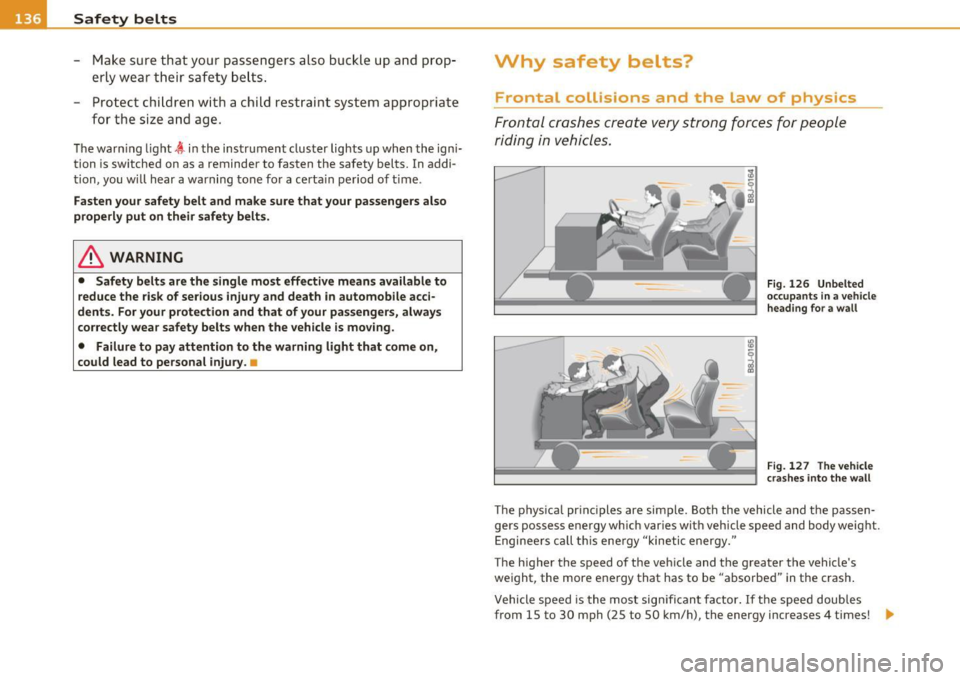
-Safety belts pn, _______________ _
-Make sure that your passengers also buckle up a nd prop
erly wear their safety belts .
- Protect c hildren with a child rest raint system appropria te
fo r the size and ag e.
The warn ing light ~ in the instrument cluster lights up when the igni
tion is sw itched on as a reminder to fasten the safety belts. In addi
tion, you w ill hear a wa rning tone for a certa in period of t im e.
Fasten your safety belt and ma ke sure that your passenge rs also
properly put on their safety belt s.
& WARNING
• Safety belts are the singl e most effective means available to
reduce the risk of serious injury and death in automobile a cci
dents . For your protection and that of your pas senger s, always
co rrectly wear safety belts when the vehicle is mo ving .
• Failure to pay attention to the warning light that come on,
could lead to personal injur y.
u
Why safety belts?
Frontal collisions and the law of physics
Frontal crashes create very stron g forc es for people
riding i n vehi cles.
Fig . 12 6 U nbelted
o ccupa nts in a vehicle
h eadin g for a w all
Fig . 127 The ve hicle
cr as hes int o t he w all
T he p hys ica l pr inc iples are simple. Both the vehicle and the passen
gers possess energy which var ies wit h veh icle speed and body weight.
Enginee rs ca ll t his ene rgy "kinetic energy."
The higher the speed of the veh icle and the greater the vehicle's
we ight, the more energy that has to be "absorbed" in the crash .
Vehicle speed is the most sig nifican t fa ctor. If t he speed doubles
from 15 to 30 mph (25 to 50 km/h), the energy increases 4 times! .,
Page 139 of 320

Because the passengers of this vehicle are not using safety belts
=> page 136, fig. 126, they will keep moving at the same speed the
vehicle was moving just before the crash, until something stops them
- here, the wall =>
page 136, fig. 127.
The same principles apply to people sitting in a vehicle that is
involved in a frontal collision. Even at city speeds of 20 to 30 mph (30
to SO km/h), the forces acting on the body can reach one ton (2,000
lbs. or 1,000 kg) or more. At greater speeds, these forces are even
higher .
People who do not use safety belts are also not attached to their
vehicle. In a frontal collision they will also keep moving forward at
the speed their vehicle was travelling just before the crash . Of course,
the laws of physics don't just apply to frontal collisions, they deter
mine what happens in all kinds of accidents and collisions.•
What happens to occupants not wearing
safety belts?
In crashes unbelted occupants cannot stop themselves
from flying forward and being injured or killed. Always
wear your safety belts!
Safety first
Fig. 128 A driver not
wearing a safety belt is
violently thrown
forward
Vehicle OP-eration
Safety belts
Fig. 129 A rear
passenger not wearing
a safety belt will fly
forward and strike the driver
Unbelted occupants are not able to resist the tremendous forces of
impact by holding tight or bracing themselves. Without the benefit
of safety restraint systems, the unrestrained occupant will slam
violently into the steering wheel, instrument panel, windshield, or
whatever else is in the way=> fig. 128. This impact with the vehicle
interior has all the energy they had just before the crash.
Never rely on airbags alone for protection. Even when they deploy,
airbags provide only additional protection. Airbags are not supposed
to deploy in all kinds of accidents. Although your Audi is equipped
with airbags, all vehicle occupants, including the driver, must wear safety belts correctly in order to minimize the risk of severe injury or
death in a crash.
Remember too, that airbags will deploy only once and that your
safety belts are always there to offer protection in those accidents in
which airbags are not supposed to deploy or when they have already
deployed. Unbelted occupants can also be thrown out of the vehicle
where even more severe or fatal injuries can occur.
It is also important for the rear passengers to wear safety belts
correctly. Unbelted passengers in the rear seats endanger not only
themselves but also the driver and other passengers=> fig . 129. In a
frontal collision they will be thrown forward violently, where they can
hit and injure the driver and/or front seat passenger. •
Vehicle care Do-it-yourselt service iTechnical data
Page 140 of 320
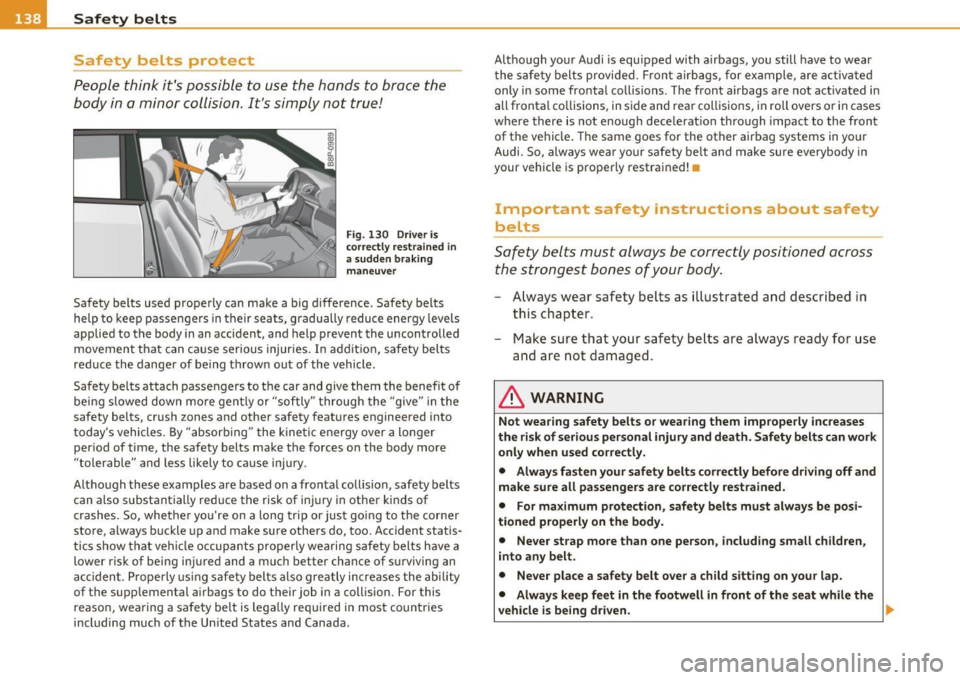
•--=S~a ~f ~e ~t ,z.Y ...: b~ e~lt ~ s~ --------------------------------------------
Safety belts protect
People think it's possible to use the hands to brace the
body in a minor collision . It's simply n ot true!
F ig . 1 30 Driv er is
c o rr ect ly res trai ned i n
a su dden bra kin g
m ane uver
Safety belts used prope rly can make a big difference. Safety belts
help to keep passengers in their sea ts, gradually reduce energy leve ls
applied to the body in an accident, and help prevent the uncontrolled
movement that can cause serious injuries . In add it io n, safety bel ts
red uce the danger of be ing t hrown out of the vehicle.
Sa fety be lts attach passengers to the car and give them the benefit of
being slowed down mo re gently or "softly" through the "give" i n the
safety belts, crush zones and other safety features engineered into
t oday 's vehicle s. By "absorb ing" the kine tic e nergy over a lo nger
period of time, the safety belts make the forces on the body more
"tolerable" and less likely to ca use inju ry.
Although these examples are based on a frontal collision, safety belts can a lso s ubstantially red uce the risk of i nju ry in other kinds of
cr ashes . So, whet he r you're on a long trip or just going to the corner
store, always b uckle up and make sure others do , too. Accident statis
t ic s show that vehi cle occupan ts properly wea ring safety belts have a
lower risk of being injured and a much better chance of surviv ing an
a cc iden t. Properly usi ng s afe ty belts also greatly in cre ases the ability
of the supp lemental airbags to do their job in a collision. For this
reaso n, wea ring a sa fety belt is lega lly req uired in mos t countries
including much of the Un ited States and Canada . Altho
ugh your Audi is equ ipped with a irbags, you still have to wear
t he s afe ty belts provided. Fron t air bags, for ex ample, are a ctiv ate d
only in some fronta l collisions . T he front a irbags a re not act ivated in
all frontal co llisions, in s ide and rear coll isio ns, in roll overs or in cases
where there is not enough decelerat ion thro ugh impact to the front
of the vehicle . The same goes for the other airbag systems in yo ur
Audi. So, always wea r you r safety be lt and make su re everybody in
your vehicle is proper ly restrained!
Important safety Instructions about safety
belts
Safety b elts must always be correctly positioned across
the strongest bones of your body.
- Always wear safety belts as illustrated and described in
this chapter.
- Make sure that your safety belts are always ready for use and are not damaged.
& WARNING
Not wea ring safety belts o r wearing them improperly inc reases
the risk of s eriou s personal injury and death . Safety belts can work
only when u sed correctl y.
• Alway s fasten your safety belts correctly bef ore driving off and
make sure all passengers are corre ctly restrained.
• For ma ximum protection , safety belts must alw ays be posi
ti oned properly on the body.
• Never strap more than one person , including small children ,
into any belt .
• Never place a safety belt o ver a ch ild sitting on your lap .
• Alway s keep feet in the footwell in front of the seat while the
vehicle is being driven.
~